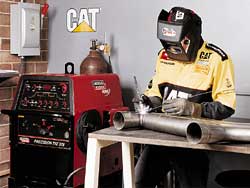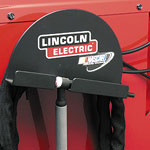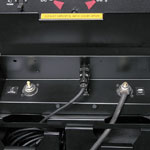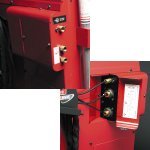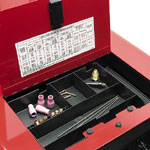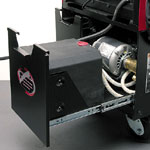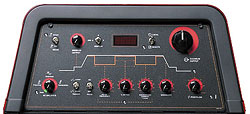Precision TIG Series 2: Value Added
In our last article regarding TIG welding products at Lincoln Electric, we focused on the outstanding arc performance of the new Precision TIG® 275 and 375 units. Innovative Micro-Start Technology™ creates a machine that offers excellent starting, superb low amperage welding output, arc decay or ‘cratering’ capabilities without high frequency and a smooth, stable arc.
In Part 2 of this series, we turn our attention to the value features provided by the Precision TIG®. These features were developed after extensive interviews with customers, distributors and sales personnel. These interviews helped Lincoln Electric’s design team zero in on what operators really want in their TIG machines, including features designed to make the operator’s jobs easier that no manufacturer had previously considered.
The R&D team also observed operators in action – noting their frustrations, habits and how they modified their machines to better fit their needs. All of this data was incorporated into the new Precision TIG® 275 and 375 power sources. What results is a machine that is superior to the competition in terms of performance, convenience and value. Here is what sets the Precision TIG® apart:
Torch Extras
TIG Holster
The Precision TIG® offers a TIG holster providing a convenient place to wrap and store the torch when not in use. This means it will always be in the same spot – you won’t have to hunt for it the next time you need to weld
Separate Process Based Output Connections
The unit has an output stud for the stick electrode holder, which is separate from the TIG torch connection. This conveniently allows the operator to simultaneously leave a TIG torch and a stick electrode holder connected and ready for operation. Since the high frequency starting output is only present at the TIG torch connection, the electrode holder cannot become a source of high frequency radiation.
Simple Connectivity
With the Precision TIG®, an operator can connect a water-cooled TIG torch without an adapter. In addition, a simple thread-in adapter may be used for air-cooled torches. A special torch connection pod is placed high on the side of the machine for easy access, intuitive connection and compartment isolation of internal water connections from the machine power system. Color-coded water and gas connections come into the pod from the rear, while torch connections are intuitively made at the front of the pod to aid understanding and keep cables neat.
Built-in TIG Filler Rod Consumable Holders
We observed that operators often were using PVC pipe bolted to the machine or other “homemade” devices to hold TIG welding filler rod consumables. Always on the cutting-edge, Lincoln developed two built-in holders for these rods. This unobtrusive storage space helps to clear up consumable clutter and reduce waste around the work site.
Top Accessible Torch Parts Bin
Watching welding operators in action proved that there was a definite need for an area to hold torch consumable parts. Because of this, Lincoln added storage space at the top front edge of the Precision TIG® for tungsten electrodes, collets, collet bodies and other parts. Secured by a hinged bin cover with latch, this storage area even has a removable tray, which gives the operator the ability to move the tray near his work.
Lockable Storage
A large drawer under the Precision TIG® in the optional cooler cart can store a full-sized helmet or a regulator, work cable with clamp and foot pedal, all without the need to disconnect during storage. Plus, the unit gives the operator the ability to lock items for safekeeping overnight or during lunch.
Storage Benefits
"Cooler in a Drawer"
The water cooler is located compactly in a drawer next to, and locks with, the storage drawer. Pulling the drawer out a short distance allows easy access to check and fill the coolant reservoir. The novel "Cooler-As-Needed" circuit runs the cooler pump only when the torch needs cooling. Similarly, the Precision TIG runs the cooling fan in a Fan-As-Needed (F.A.N.) mode, operating only when the welding machine requires cooling.
Better Controls
Control Layout
To aid in the set-up process, Lincoln created the Precision TIG to be very user-friendly, with all the controls laid out in a logical left to right fashion. The control panel is organized by sequence of welding process – first you select mode and polarity, then set the welding parameters, such as welding amperage and pulsing controls. Complete the process by setting downslope and post-flow. An added advantage is that the controls are at an easy-to-reach height to eliminate bending and straining every time a parameter needs to be adjusted.
Understandable Symbols and Labels
To make it easier for even the novice welding operator to understand, Lincoln uses symbols that relate to what the operator “sees” at the arc. For example, rather than labeling the Balance control as a percentage of positive vs. negative output, Lincoln related the balance control to what effect it has during welding – so the balance control knob is labeled “cleaning vs. penetration” with symbols to match.
Well-Spaced and Angled Controls. A gloved hand will have no problem setting Precision TIG® well-spaced, large knobs. Also, the control panel is angled so it is easy to read and recessed to offer protection.
Visually Appealing. Large symbols and indicator lights allow the control panel to be seen from a distance. In addition, when setting the pulse frequency, a light indicates this feature is activated and also flashes at the same speed as the arc’s pulsing rate. Attention to details such as this appeal to both the skilled operator and the novice attempting to set the machine even before striking an arc.
Other Features
Cable Management System
Eliminating clutter is the reason Lincoln’s machines come standard with a cable management system. No cables on the floor mean less chance of injury and less cable damage. And, side connections keep torch cables out of the way.
Simple Set-up
With competitive models, such as the Miller Electric® Synchrowave® units, an electrician must crimp on the terminal ring-lugs to hook up the input power cable connections. However, Lincoln’s Precision TIG models provide for simpler set up – operators only need to strip the wire, put it in the clamp and tighten. In addition, the Lincoln machines are designed to allow power cables to run straight into the connection box, so no wire bending is necessary. In contrast, the Miller units have access panels that are hard to use, low to the floor and require right angle bends in the wire.
Minimized Dirt Contamination
Not only does the Precision TIG® use Fan-As-Needed (F.A.N.) to minimize the amount of external debris being drawn into the machine, but it also uses the new ‘push-pull’ cooling fan concept. This approach is designed to pull air into the machine through top rear vents (not from the floor area as with some competitive machines), and push it out through bottom rear vents. Since cooling air vents are only on the back of the machine, there is less chance for undesirable contaminant entry, as is possible with case designs featuring vents all around the machine.
Flip Up Door
Precision TIG® units feature a flip up parts bin door with a TIG selection chart for easy consumable selection.
Machine Height
Lincoln Electric’s team observed that, in many shops, operators built pedestals to make the machine higher so an individual seated at a workbench would not have to bend down to change settings. Precision TIG® units are built taller to provide comfortable operation.
Minimized Footprint
In most small fabrication shops, floor space is at a premium. The Precision TIG® 275 and 375 were designed to fit in a corner or against a wall. If the undercooler option is purchased, it tucks under the machine, rather than adding to the required footprint like some competitive stand-alone coolers.
Ergonomic Foot Pedal
Much like the gas pedal on a car, the ergonomic design of the unit’s foot pedal is comfortable for your foot and easy to depress. The typical foot angle required for use is designed to allow the operator to easily go through a comfortable range of motion without putting strain on leg muscles. The foot pedal has a wide stance so it won’t tip and is housed in a rugged, metal case to stand up to even the most demanding shop environment. When used with the Precision TIG models, the minimum and maximum pedal output are presettable for optimum starting and control. For those who desire arc start foot pedal control independent of normal welding foot pedal control, the K870-1 Start Pedal Foot Amptrol™ is also available.
Low Cylinder Platform
Lincoln's Precision TIG® 275 and 375 shielding gas cylinder platform minimizes lifting of heavy shielding gas bottles.
Power Factor Correction
The Precision TIG® 375, in particular, comes with standard power factor correction, competitively priced against units that do not include this money-saving feature. Most people operating a 350 amp power source in a production environment indicated they would like to have this feature as part of the machine, rather than have to order it separately (available as an option on the Precision TIG® 275). Power factor correction helps shops reduce their electric power consumption expenses.
Pulsing
Unlike the competitive Miller® Synchrowave® model, Lincoln’s Precision TIG® 375 offers pulsing functions as a standard feature. With this unit, there is no need to purchase an additional sequencer or pulser to add pulsing or down slope capability.
Price
Not only does Lincoln offer more standard features than the competition, the Precision TIGs are offered at a lower price. For example, the Precision TIG® 375 is up to $730.00 (US) less than the Miller Electric® comparably equipped Synchrowave® 350LX. The Precision TIG® 275 is also priced less than the comparable competitive model.
Overall Value
Go ahead – compare the Precision TIG® to the competition! Lincoln asked what the customer wanted and then delivered. Precision TIG® models offer better performance, more features and more value…why would you think of looking at anything else?
Miller Electric® and Synchrowave® 350 LX are registered trademarks of the Miller Electric Mfg. Company.

